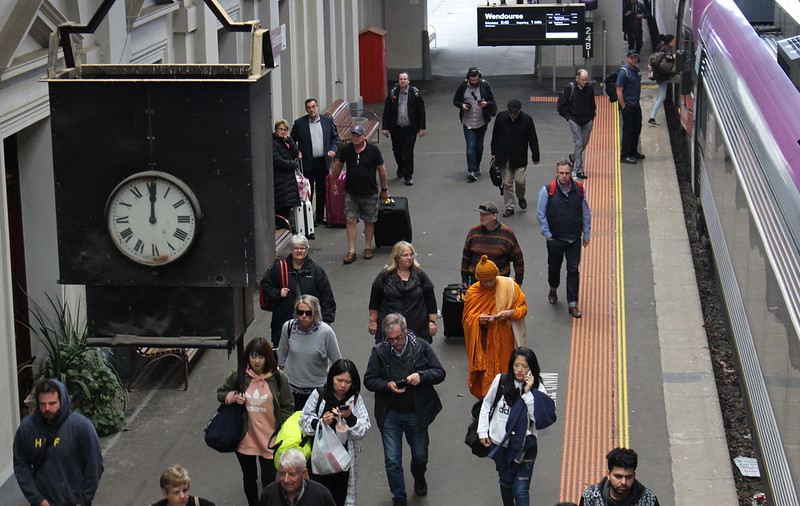The concept of a Travel Time Budget, also known as Marchetti’s constant, was mentioned in conversation last week, and it got me thinking.
Marchetti posits that although forms of urban planning and transport may change, and although some live in villages and others in cities, people gradually adjust their lives to their conditions (including location of their homes relative to their workplace) such that the average travel time stays approximately constant.
Wikipedia
The transport planning perspective on this is that if you upgrade transport infrastructure and services to help people save time, eventually they just end up using more time to travel further.
Not everybody of course, but an average.
This has happened before. The Regional Fast Rail upgrades of the mid-2000s were widely seen as enabling commuting from areas around Geelong, Ballarat, Bendigo, Seymour and Gippsland into Melbourne. Between 2004 and 2010, V/Line patronage grew by an amazing 88%. (Related: if you run faster trains, more often, people will use them.)
The big question is: how will Marchetti’s constant work following the fallout from COVID-19?
While nobody knows exactly what will happen, it’s widely predicted that many people pre-COVID who had been working five days a week in the office will post-COVID switch permanently to part time in the office, part time at home.
As noted in this article, some people, anticipating commuting to a CBD office less often, are moving further out, in return for more space and cheaper housing. But so far it’s all anecdotal.
After 18 months of working from home and not seeing family in person, the concept crossed my mind. Many of us are in jobs where most of the work can be done remotely from anywhere with a fast reliable network connection. It’s the face-to-face collaboration which is likely to be the most valuable time in the office – but for many people that’s only part of their regular working week.
So in theory at least, you could give up your expensive Melbourne house, move to a country town and buy/rent a still nice (but far cheaper) house with good internet, near a railway station, and pocket the difference.
My usual rail commute is 30 minutes. If you had to go into the office less often, how much further would you be prepared to travel? There’s a limit of course – one day per week in the office probably wouldn’t equate to being willing to travel 2.5 hours each way on a regular basis.
In fact for many towns beyond the V/Line commuter belt services, there’s no train arriving into Southern Cross before 9am, though there are coach options for some, and options are improving on some lines.
If you were in the office more than one day a week, a long commute from a regional town perhaps could be partly countered by renting or buying a cheap studio apartment in or near the CBD to use. Spend some of the week in the office/apartment, the rest of the time in your country bolthole.
A less nuclear option is outer Melbourne rather than regional Victoria – if you can find a patch of suburbia similar to your own, with the services and amenity you want. Just don’t expect a tram (or any other public transport) every 10 minutes at the end of your street.
Wild ideas, but would it actually work?
For me, I quickly came to the conclusion that if the current lockdown means isolation from friends and family, then moving too far away would lock this in permanently. For me, that outweighs the benefits.
But it might work for some people.
RMIT student and blog reader David Stosser is doing some research on Travel Time Budgets. He’s got a survey running: there’s more details here, and you can respond to the survey here.


7 replies on “Marchetti’s constant”
Thanks Daniel :)
For what it’s worth, a HILDA survey in 2012 of about 9000 Australian commuters to paid employment found that the average time was 28min, and:
41% were 1-15min
29% were 16-30min
10% were 31-45min
13% were 46-60min
14% were 61min or longer.
Note this doesn’t account for other commutes i.e. students, volunteers or regular social activities, nor other trips of any type.
The survey was referenced in the BITRE 2016 report no.144, “Lengthy Commutes in Australia”
https://www.bitre.gov.au/publications/2016/rr_144
The report also notes that transit commutes were, on average, longer than car commutes, partly due to more transit commutes being radial to higher-paid CBD roles which offset the extra time cost, but that indicates to me that radial heavy rail public transport can’t really be competitive for (say) the 41% of people who have much shorter commutes, and that means we need a vast improvement to the local bus networks. Ideally something in the range of quadrupling services.
Interesting. I think the “friends and family” effect is definitely a wildcard here, and perhaps less easily quantifiable than access to jobs or “amenity” (like cultural events).
For me, one of the reasons I’m quite happy to stay in Ballarat is that a bunch of my friends and family live here – places like Bendigo and Geelong tick a lot of my other boxes, but because I don’t know many people there, I’m a lot less keen on them.
It will therefore be interesting to see if there’s a bit of a “follow the leader” effect. If you’re in your mid-30s and all your friends live in Melbourne, but half of them suddenly decide to move out to a regional city in search of cheaper home ownership, will that tempt the rest to follow them?
I’ve moved to South Gippsland since COVID, while retaining my flat in inner Melbourne for use a couple of days a week when we return to the office, confirming one of your options noted above as perfectly viable. A return day trip to Melbourne isn’t feasible from where I am as it’s a 30 min drive to the nearest station, then an almost 2 hr train trip (which is partly offset from being able to work on the train). Hoping the improvements on the Gippsland Line are completed before that happens though!
@David, I seem to remember some data from North American cities that showed average travel time was remarkably constant over time.
@simbera, interestingly one couple in our extended family moved from northern Melbourne to the SW outskirts of Ballarat a few years ago. A lovely big house with a huge garden. The idea was a commute by train into central Melbourne would be manageable for the husband. It’s turned out to be too much; last I heard he was hunting for a local role.
As for following friends to the country, what if they all head in different directions?!
@Adam, how do you find it in terms of contact with family and friends? Do you think you’ll commute into Melbourne often?
On balance it’s been for the better but it’ll be good to be able to travel to Melbourne freely if we ever get back to ‘normal’. I’m planning to commute weekly as work is offering 2 days in the office/ 3 days at home. I reckon that will work pretty well, and if I make it a Thu/Fri in the office that offers staying for the weekend for social reasons.
@Daniel,
Yes, average travel time across a society is fairly constant, but within that, certain demographics i.e. age, career stage, qualifications etc have different constant or average values. Examples from the above-linked BITRE report into lengthy commutes, defined as people who commute 45min or longer each way each day:
* 26% of employed people with a Batchelor degree or higher are lengthy commuters, vs 16% with Year 11 or below qualifications.
* Earning more than $150kpa = 36min average commute, vs $20-30kpa average 26min (2012 $ values).
* Sydney outer suburbs mass transit commuters average 79min; only 10% of mass transit users in those areas commute <45min.
It will be interesting to see what happens in the following years with outer-suburban or V-line country lines.
Personally I have commuted to university and the Melbourne CBD regularly from Gippsland and it’s totally do-able with the overall caveats:
-The base location of friends/family is a key reason to stay around them
-The comfort and busyness of the trains matter. V-line has much improved the adoption of air-plane type tray tables to be able to do work. When it is too busy and people have to stand productive type work is out of the question
-Whether people treat there commute time as the same value ‘alive time’ to being at work. Where they could study, read etc, compared to ‘dead time’. This probably suits introverts more so, and assumes people have the self-commitment to do these things and not get distracted with talking to others or social media.
-The cost of commuting to these areas. At roughly existing $15-$20 each way, compared to $4.50 each way for metro. For 3 days a week that could be $120, or $6,000/year/person. So a 4 person household could be around $25,000/year, compared to roughly $5,000 for zone 1/2 equivalent. Would it be worth moving for an approximate $20,000 more cost, or $400/week? On-top of the general inconvenience/annoyance that any transport brings compared to not requiring it. Very much depends on how many days a week and the number of the members of the family who do this.